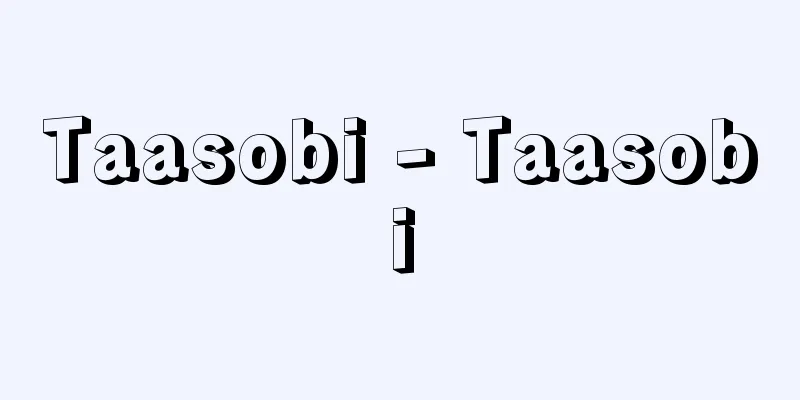Kashiwamochi - Kashiwamochi

|
A type of mochi confectionery. It is a flat, oval-shaped piece of new flour mochi stuffed with miso paste or red bean paste, folded in half, and steamed in a oak leaf. It is used as an offering along with chimaki on the Boys' Festival. During the Edo period, the famous kashiwamochi was available at tea shops in Shirasuka-shu and Sarugababa, Nakama, Futagawa-shu (both in Shizuoka Prefecture), on the Tokaido. The Manyoshu states, "When at home, rice is served in a wooden tray, but when traveling, rice is served in Japanese chestnut leaves," and in ancient times, hard leaves were used as simple tableware. Camellia, bamboo grass, cherry blossom, kaji, persimmon, and oak leaves were also used. In particular, "kashiwa" was considered to be a type of leaf bowl or leaf plate, and a kashiwade was the person in charge of them, because oak leaves are flexible and ideal for serving food. However, records of kashiwamochi are not as old as those of camellia mochi. They are believed to date back to the Middle Ages, and the custom of eating kashiwamochi on Boys' Day dates back to the early Edo period. The 1680 (Enpo 8) Haikai Muko no Oka contains a witty haiku in reference to kashiwamochi: "Mochi nari kyo nin o migaku tamagasa." Meanwhile, the Tensho Nikki records an entry for July 23rd that reads, "Gorobei's wife has brought the kashiwa mochi," which shows that the sweet was made on occasions other than Boys' Day. In some regions, it is also used as an offering during Obon. Kashiwamochi is used on May 5th, the boys' festival, because the old leaves fall when the new leaves of summer appear, signifying the birth of an heir, and is imbued with feelings of celebration and prayer for the prosperity of the family. The practice of filling the mochi with red bean paste came about after the manju of the Muromachi period, but the origin of the miso paste can be traced back to the hanabiramochi of the Heian period. An even older form was the futo (a Chinese confectionery called futo) of the Nara period. The shape of kashiwamochi, which resembles the hanabiramochi, gave rise to the riddle-like Edo senryu poem mentioned above. [Fumio Sawa] [Reference] |Source: Shogakukan Encyclopedia Nipponica About Encyclopedia Nipponica Information | Legend |
|
餅菓子の一種。楕円(だえん)形扁平状の新粉餅でみそ餡(あん)や小豆(あずき)餡をくるみ、二つ折りにしてカシワの葉で包み蒸した餅。端午の節供には粽(ちまき)とともに供物(くもつ)に用いる。江戸時代は、東海道白須賀宿(しらすかしゅく)と二川宿(ともに静岡県)の中間猿馬場(さるがばば)の茶店に、名物の柏餅があった。『万葉集』に「家にあれば笥(け)に盛る飯を草枕(くさまくら)旅にしあれば椎(しい)の葉に盛る」とあるが、古代は堅い葉が簡便な食器として使われた。ツバキ、ササ、サクラ、カジ、カキ、ナラの葉なども用いられている。とくに「かしは」が葉椀(くぼて)、葉盤(ひらで)の類とされ、膳夫(かしわで)がそれをつかさどる人とされたのは、カシワの葉がしなやかで、食べ物を盛るのにはもっとも都合がよかったからである。しかし柏餅の記録は椿餅(つばきもち)ほど古くない。推定されているところでは中世以降で、端午の節供に柏餅を食べる慣習は、江戸時代初期からである。1680年(延宝8)の『俳諧向之岡(はいかいむこうのおか)』には、柏餅にちなんで「餅なりけふ世人はをみがく玉がしは」としゃれた一句が収載されている。一方『天正(てんしょう)日記』の7月23日に「五郎兵衛嬶(かかあ)、かしはもちくれる」とあり、この菓子が端午の節供以外にもつくられたことがわかる。また、お盆の供物に使う地方もある。 男子の節供である5月5日に柏餅が使われたのは、夏の新葉が出るころに古い葉が落ちる、つまり跡継ぎができたという意味で一家繁栄を祈り、祝う心情がこめられている。中身の餅に小豆餡を入れるのは室町時代のまんじゅう以後のことだが、みそ餡のほうは、原型を平安時代の花びら餅までたどることができる。さらに古い形は奈良時代の伏兎(ふと)(唐菓子の飳(ふと))であった。その花びら餅に似ている柏餅の形が、前記のように判じ物的な江戸川柳(せんりゅう)をつくらせたのである。 [沢 史生] [参照項目] |出典 小学館 日本大百科全書(ニッポニカ)日本大百科全書(ニッポニカ)について 情報 | 凡例 |
>>: Kashiwabara-juku - Kashiwabara-juku
Recommend
Buckling
A phenomenon in which, when pressure is applied t...
Gallipoli
Gallipoli is a peninsula in northwestern Turkey t...
Abraham's Breast - Abraham's Breast
...But the original idea of purgatory was prese...
Supporting role - Wakiyaku
1. In a movie or play, the role that supports the ...
Kouyabouki - Kouyabouki
A deciduous shrub of the Asteraceae family (APG c...
asphodelos
...The daffodil seen in this legend is said to be...
Mock orange (English spelling) mockorange
... P . coronarius L. has been cultivated in sout...
Kasatkin, ID (English) KasatkinID
...later Archbishop (since 1906). Secular name: I...
Name of the head of a road
A representative local governor of the early Nara...
voluntaristic theory of action
… Parsons made his debut in academia in 1937 with...
Trichopitys
… In 1896, Hirase Sakugoro was the first to disco...
styrax
…It is also called styrene, styrol, vinylbenzene,...
Akita Jounosuke
Commander of the Chin'ei (guard) of Akita Cas...
vidian neuralgia
...Treatment is the same as for migraine headache...
Karuta - Karuta (English spelling)〈Portuguese〉carta
Play gambling Gambling These are cards used for Ne...









